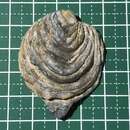pms
nòm ant ël fil


Chama lazarus ist eine Muschel-Art aus der Familie der Hufmuscheln (Chamidae).
Das ungleichklappige Gehäuse wird bis 10 cm groß. Es ist im Umriss unregelmäßig rundlich oder eiförmig. Meist ist die linke Klappe fest zementiert auf einem Hartgrund. Die untere Klappe ist gewölbt und tassenförmig, die flache obere Klappe fungiert als Deckel. Die Wirbel sind weit spiralig nach vorne gebogen. In der Aufsicht auf die festgewachsene Muschel ist somit der Wirbel nach rechts eingedreht.
Das extern liegende Ligament ist bogenartig gewölbt und liegt auf Nymphen. In der unteren Klappe sind zwei Hauptzähne vorhanden, ein breiter vorderer Hauptzahn und ein langer, schmaler hinterer Hauptzahn und ein hinterer Seitenzahn. In der oberen Klappe ist ein langer, schmaler Hauptzahn und eine weite Grube vorhanden sowie ein hinterer Seitenzahn. Die zwei Schließmuskeln sind nahezu gleich groß. Eine Mantelbucht fehlt.
Die aragonitische Schale ist dickwandig und sehr fest. Die Oberfläche weist eine kräftige konzentrische und radiale Lamellen auf, die randlich zu blattförmigen Fortsätzen verlängert und verbreitert sind. Die Farbe ist variabel, von weißlich, gelblich, orange bis rötlich.
Die Siphonen sind kurz und voneinander getrennt. Der Fuß ist stark reduziert. Im Mantelrand sind sensorische Organe.
Chama lazarus lebt im Indopazifik; die Art kommt von Ostafrika bis nach Melanesien, und von den Amami-Inseln (Südjapan) bis Australien vor. Die Art lebt im Flachwasser von Korallenriffen und anderen Hartsubstraten, aber auch in größeren Wassertiefen.
Die Art wurde bereits 1758 von Carl von Linné aufgestellt.[1] Es ist die Typusart der Gattung Chama Linnaeus, 1758.[2]
Chama lazarus ist eine Muschel-Art aus der Familie der Hufmuscheln (Chamidae).
Chama lazarus, common name the Lazarus jewel box, is a species of cemented saltwater clam, a marine bivalve mollusc in the family Chamidae, the jewel boxes.
Chama lazarus has a shell that usually grows to about 75 mm, with a maximum length of 140 mm. The outer surface of the shell is reddish or pale brown, and shows long, branched, leaf-like spines.
This invasive species is widespread in the Indo-West Pacific, from East Africa, including the Red Sea, to Melanesia; north to Japan and south to Queensland. The distribution includes Australia, Philippines, New Caledonia, Papua New Guinea, Japan, Malaysia, Singapore, Eswatini, Solomon Islands, Taiwan, South Africa, British Indian Ocean Territory, Fiji, Thailand, Comoros, Madagascar, Micronesia and Guam.
It can be found on rocks and corals in low intertidal zone and sublittoral to depths of about 30 m.
Chama lazarus, common name the Lazarus jewel box, is a species of cemented saltwater clam, a marine bivalve mollusc in the family Chamidae, the jewel boxes.
Chama lazarus is een tweekleppigensoort uit de familie van de Chamidae.[1] De wetenschappelijke naam van de soort is voor het eerst geldig gepubliceerd in 1758 door Linnaeus.
Bronnen, noten en/of referenties翘鳞猿头蛤(学名:Chama lazarus),又名菊花偏口蛤,是帘蛤目偏口蛤科偏口蛤属的一种[1],也是這個屬的模式種[2]。
主要分布于南海、新加坡、马来西亚、印度尼西亚、中国大陆、台湾,出现在潮间带至潮下带,生活于浅海,以左壳固着于珊瑚礁、岩石和船底,终生不移动[1]。